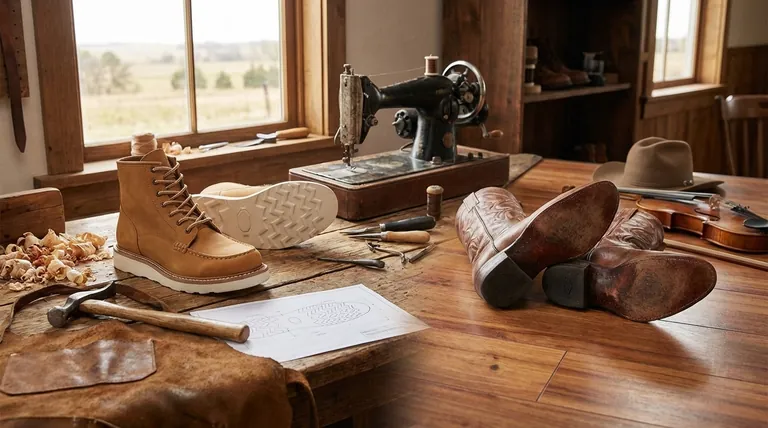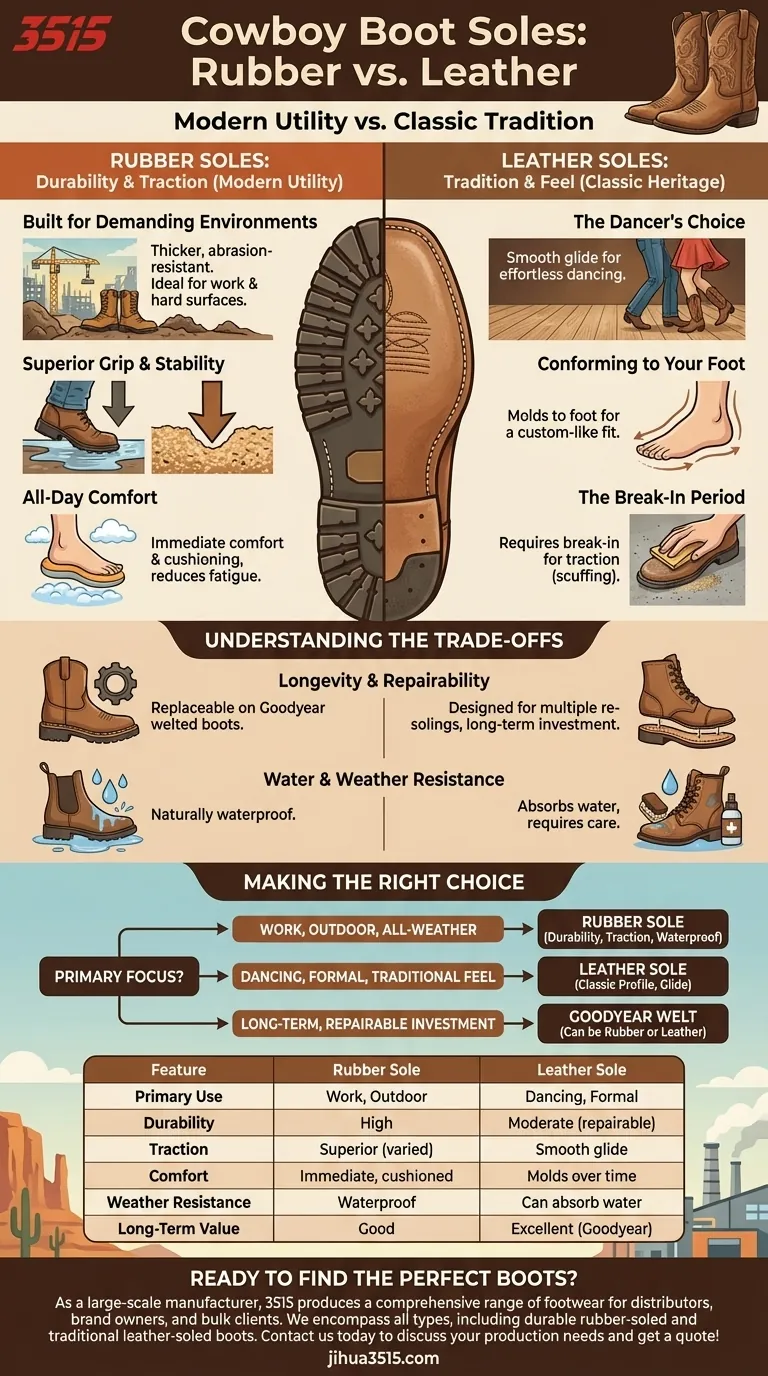At their core, the differences between rubber and leather soles on cowboy boots come down to a choice between modern utility and classic tradition. Rubber soles offer superior durability, traction, and immediate comfort for work or unpredictable terrain. Leather soles provide a traditional feel, mold to your foot over time, and are the standard for activities like dancing that require a smooth glide.
The choice is not about which sole is universally "better," but which is the right tool for your specific purpose. Rubber is built for performance and harsh environments, while leather is crafted for tradition and feel.

The Case for Rubber Soles: Durability and Traction
Rubber soles are engineered for performance, providing a practical foundation for a modern working boot. They excel in environments where grip and longevity are paramount.
Built for Demanding Environments
Rubber is inherently thicker and more resistant to abrasion than traditional leather. This makes it the ideal choice for rigorous activities, construction sites, or long hours standing on hard surfaces.
Superior Grip and Stability
A key advantage of rubber is its superior traction. It provides a secure grip on a wide variety of surfaces, from wet pavement to workshop floors covered in sawdust, significantly reducing the risk of slips.
All-Day Comfort
The thickness and shock-absorbing properties of rubber provide immediate, out-of-the-box comfort. This cushioning helps reduce fatigue during long days on your feet.
The Case for Leather Soles: Tradition and Feel
Leather soles represent the heritage of the cowboy boot. They are valued for their classic profile, breathability, and unique ability to adapt to the wearer.
The Dancer's Choice
For dancing, leather is unparalleled. Its smooth surface allows for the effortless gliding and spinning essential for two-stepping and line dancing.
Conforming to Your Foot
Over time, a leather sole gradually molds to the unique shape of your foot. This creates a custom-like fit that many wearers find exceptionally comfortable after the break-in period.
The Break-In Period
New leather soles are notoriously slick. They require a break-in period where scuffing them on rough surfaces like concrete creates the texture needed for proper traction in everyday walking.
Understanding the Trade-offs
Choosing a sole involves more than just its primary use case. You must also consider factors like repairability, weather resistance, and long-term value.
Longevity and Repairability
A common misconception is that rubber soles cannot be replaced. High-quality boots with a Goodyear welt construction can have their rubber soles replaced by a skilled cobbler.
However, traditional leather-soled boots are almost always designed to be re-soled, often multiple times. This can significantly extend the overall life of the boot, making it a long-term investment.
Water and Weather Resistance
Rubber is naturally waterproof and offers far better protection in wet or snowy conditions. Leather, on the other hand, can absorb water, which can lead to damage and deterioration if not properly cared for and dried.
Making the Right Choice for Your Needs
Your intended use for the boots should be the deciding factor.
- If your primary focus is work, outdoor use, or all-weather wear: Choose a rubber sole for its superior durability, traction, and moisture resistance.
- If your primary focus is dancing, formal events, or a traditional feel: Choose a leather sole for its classic profile and ability to glide on smooth surfaces.
- If your primary focus is a long-term, repairable investment: Prioritize a boot with a Goodyear welt construction, which allows for re-soling regardless of whether you choose rubber or leather.
Ultimately, selecting the right sole is about choosing the proper foundation for where you plan to go.
Summary Table:
| Feature | Rubber Sole | Leather Sole |
|---|---|---|
| Primary Use | Work, Outdoor, All-Weather | Dancing, Formal, Traditional |
| Durability | High | Moderate (but repairable) |
| Traction | Superior on varied surfaces | Smooth glide (requires break-in) |
| Comfort | Immediate, cushioned | Molds to foot over time |
| Weather Resistance | Waterproof | Can absorb water |
| Long-Term Value | Good | Excellent (if Goodyear welted) |
Ready to find the perfect cowboy boots for your needs?
As a large-scale manufacturer, 3515 produces a comprehensive range of footwear for distributors, brand owners, and bulk clients. Our production capabilities encompass all types of shoes and boots, including durable rubber-soled work boots and traditional leather-soled classics. We can help you source or create the ideal boot to meet your market's demands.
Contact us today to discuss your production needs and get a quote!
Visual Guide

Related Products
- Durable Moc Toe Wedge Sole Work Boots for Wholesale and Private Label
- Durable Rubber-Soled Utility Shoes for Wholesale & Custom Brand Manufacturing
- Wholesale Leather Ankle Boots with Lug Soles for Custom Brand Manufacturing
- Wholesale Classic Leather Lace-Up Ankle Boots for Brand Manufacturing
- Durable Leather Work Boots for Wholesale & Custom OEM Manufacturing
People Also Ask
- What are the key differences between men's and women's work boots? Ensure Safety & Comfort with the Right Fit
- What weather-related protections do work boots offer? Essential Guide to Dry, Warm, & Safe Feet
- How do wedge sole work boots prevent slips and falls? Maximize Grip on Concrete & Hard Floors
- What are some reported advantages of this work boot from user reviews? A Durable Investment for Demanding Jobs
- Why are slip-on moc toe shoes a practical choice for formal events? Unlock Effortless Style & Comfort



















